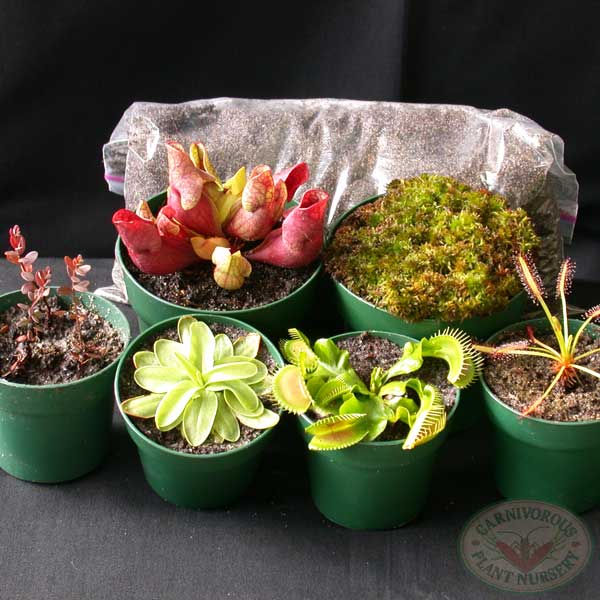
How to Pot a Carnivorous Plant
How to Pot a Carnivorous Plant
Potting carnivorous plants is easy. You will need these things:
1. Carnivorous Plant
2. Carnivorous Plant Soil Mix
3. Plastic Pot
4. Mineral-free water (spray bottle optional)
5. Tweezers (optional)
Carnivorous Plant Nursery generally ships carnivorous plants that are bare-root and wrapped in long fiber sphagnum moss, with an outer wrapping of paper toweling. This is secured with a small rubber band and a plant label. To properly plant the carnivorous plant gather the Carnivorous plant soil, plastic pot and mineral-free water. You may find tweezers helpful.
Carnivorous plant soil is sold in our online store. In general our Carnivorous Plant Premium Soil Mix works best for most carnivorous plants. (Nepenthes, Butterworts and Bladderworts have separate soil mixes available). These soils are specially prepared for carnivorous plants and are mineral-free. Pre-moisten the soil by adding mineral-free water to it. Be sure the soil is very damp. Dry soil can pull moisture from the plant and may kill it.
DO NOT use regular houseplant potting soil. The minerals and fertilizers in these mixes will eventually kill your CP. The nutrient poor soils to which the carnivorous plants have adapted are often rich in peat and sand. You can duplicate this with a soil mixture of sphagnum peat moss and horticultural sand. Be sure to check the peat label for sphagnum moss. Other types of peat (sedge peat) will not work well. The sand should be clean and washed. Play box sand is great or you can buy horticultural sand. Avoid "contractor’s sand" which will contain fine dust, silt, clay and other minerals. Never use beach sand. The salt content will harm the plants. The ratio of the mix is not critical, 1 part peat with 1 part sand works well for most carnivorous plants. Flytraps prefer a bit more sand, and Nepenthes prefer much more peat, but again the mix is not critical, as long as it is sphagnum peat and clean, washed sand.
Plastic pots are best for carnivorous plants. They will not leach minerals into the soil like a terra-cotta or ceramic pot. A completely glazed ceramic pot will work, but plastic is best. The pot should have atleast one hole in the bottom. The size of the pot should be proportional to the plant. Small and medium sized Venus Flytraps and sundews will grow well in a 3" pot, but a large or extra large plant will need a 4" or 6" pot. Most pitcher plants and butterworts will do fine in a 4" pot.
Always use mineral-free water with your carnivorous plants, such as rainwater or distilled water. Try keeping a bucket near the downspout to collect rainwater. Distilled water can be purchased at the grocery store, but avoid bottled drinking water. There are simply too many minerals in it. The condensation line from an air conditioner or heat pump is another source of mineral-free water. Reverse-osmosis (RO) water is fine to use. Carnivorous plants grow in nutrient poor soils. The minerals from tap water can "over-fertilize" and "burn out" the plants.
Remove the packing material by carefully removing the rubber band, and unwrapping the long fiber peat moss used to pack the roots. It is a good idea to briefly soak the roots in mineral-free water to moisten them up. A shallow layer of long fiber sphagnum moss in the bottom of the pot will help keep soil from coming through the pot holes. Add Carnivorous Plant soil to the plastic pot, and gently pack it down. The soil level should be to the top of the pot. Covering the hole at the bottom of the pot with a small stone or a small bit of sphagnum moss is optional. Use a small stick or your finger to poke a small hole into the soil, in the center of the pot. The hole needs to be deep enough for the size of the plant. You may prefer to use tweezers to gently handle the plant and place it into the pot. Plant the Carnivorous Plant deep enough so that the roots are completly underground and the crown of the plant is above the soil level. On most Carnivorous Plants and especially the venus flytrap, you should be able to see that the top of the plant is green, while the bottom of the plant is white. The green portion stays above the soil, and the white portion goes under the soil. Push the soil around the Carnivorous Plant so that soil surrounds the plant crown, but be careful not to bury the crown. Moisten the soil surface with a spray bottle or gently pour a small amout of water on the soil surface. Be careful not to wash away the soil.
Carefully adjust your plant so that it is growing upright. Any soil that may stick to the plant can be gently washed away using a spray bottle. Do not worry if the plant looks a bit stressed from potting and handling. It should show new growth and start to recover with a day or so.
Remember that some plants are shipped dormant, especially during the cold months. If your Carnivorous Plant is dormant, it will begin to grow, once it is placed into healthy Carnivorous Plant conditions.
To learn more about growing Carnivorous Plants, see General Care of Carnivorous Plants.
